i'm ditching american breakfast (for now at least)
Another personal essay. My thoughts after researching breakfast foods around the world, and my reflections on the most important meal of the day.
Traditions & Nostalgia
In my personal essay, i cook to remember, I ramble on about how breakfast has been a meal wrapped in nostalgia. Weekend delights included bacon that’s a little too crispy, the frozen Eggo or now homemade yeasted waffle, soft scrambled eggs coated in Kerrygold butter, and out of season berries or citrus.
Breakfast was served as something quick and on the go, like buttered toast or clumpy grey steel cut oats out of thermos, or a comforting ritual of a plate of Americana. I love a traditional American breakfast, it’s easy, it’s versatile, and reminds me of what home used to be like with my family.
Now as an adult, I keep forgetting that I can actually eat whatever I want for breakfast and remembering that everyone else in the world eats something different. It didn’t really hit me that traditional bacon, eggs and waffle combo was a unique thing to America until I went to HEIM, a brunch cafe in Lisbon, Portugal. A few friends and I were in search of hearty breakfast. In my google search, grazing for a menu that would satisfy my hunger. I subconsciously was looking for familiarity, rather than a local experience; a creamy iced vanilla lattes with a shot of oat milk, scrambled eggs, side of protein, avo toast, very cali, very coastal.
Heim Cafe sits at the bottom of a cobblestone hill with scrawny metal seats and tables not meant for anyone with bigger than a size 2, limited condensed seating indoors accented with ecru plastered walls accented with house plants that is reminiscent of a string of small brunch cafes in Williamsburg, Brooklyn. No reservations, walk-in’s only full of Americans, British, and few Portuguese. I ordered a avocado toast, side of protein I can’t remember, and a decadent crunchy and pillow soft churro cream cheese french toast for the table to share (the real star). It is quite possible that the Portuguese has outdone American Brunch.
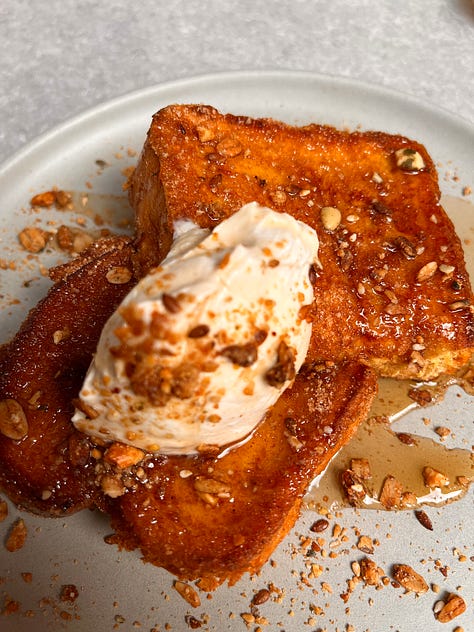
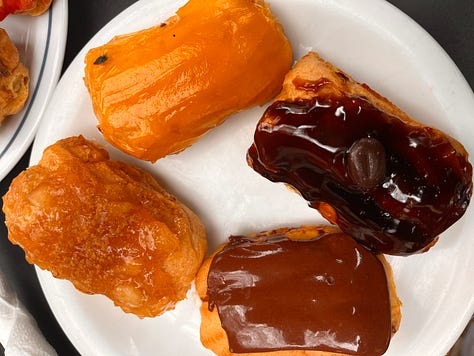
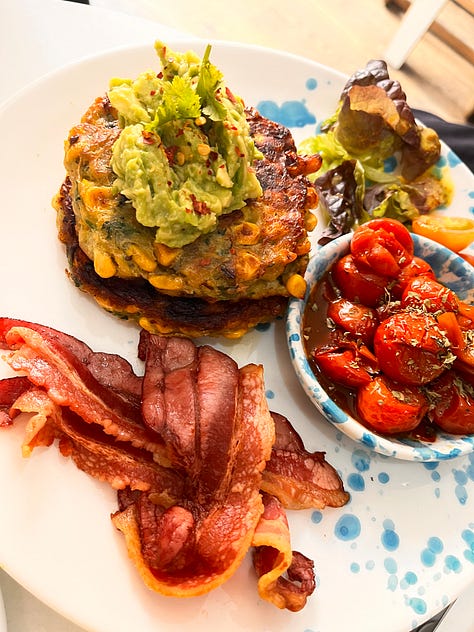
The thing is the Portuguese don’t really eat breakfast. Their mornings start a tad later than Americans and breakfast consist of a blood sugar spiked pairing of an espresso and a pastry. In 2023, it has been reported that there has been 44% rise in Americans living in Portugal, most of them coming from California. American gentrification has taken storm parts of Portugal, Mexico, just to name a few and changing cultural food customs.
Quick history lesson
The "classic" American breakfast, the one see the tv, the food we might have eaten as first generation kids with parent’s trying to assimilate into American culture. In the late 19th and early 20th centuries, breakfast was often heartier and interesting, with people eating leftovers from the night before, simple porridge-based meals, or bread as a staple.
But then came the rise of food marketing. John Harvey Kellogg, a physician and nutritionist, was one of the first to white wash and promote processed cereal as a "healthy" alternative to traditional breakfast foods. He believed that bland, fiber-rich foods would help curb "unhealthy desires" (he was famously anti-pleasure in all forms). This led to the birth of cornflakes and the sugary cereal industry that dominated American mornings.
Then came the bacon and eggs era, a 1920s marketing campaign by Edward Bernays, the"father of public relations." Hired by a pork company, he convinced Americans that a plate of bacon and eggs was not only delicious but essential for a good start to the day. For a New Yorker, a baconeggandcheese is essential the morning after a night of drunken debauchery.
By the mid-20th century, the American breakfast became routine: cereal, eggs and bacon, toast on the side, and a glass of juice to wash it all down. The diversity of breakfast—once shaped by regional and cultural influences—was largely erased in favor of uniformity, convenience, and profit.
Nyam
Jamaican Patois word for “eat”
The BED plate was the breakfast I grew up eating, but I began to question our generic choices for breakfast, which usually is determined by accessibility and ease. For years, I accepted the American breakfast as the breakfast, never questioning my grandmother’s choice’s for breakfast, fish, sautéed veggies, and starch that came in the form of a dumpling or fried plantain which would be served to me each visit. As I remember the taste of my grandmother’s breakfast I started to think more critically about my food choices. I realized I wasn’t actually excited about what I was eating. As my body changes, so do my nutritional needs, and I’ve been looking to explore other things for breakfast outside of the usual avocado toast, breakfast sandwich, and overnight oats. Staple breakfast for me usually was a smoothie, yogurt parfait, or avocado toast. However, sugar despite it being natural still left me lethargic and out of energy, craving a nap at 10am.
In 2023, I went to Aruba with my girls for a friend’s bachelorette where we rented a villa 15 minutes on the outskirts Noord, a town known for its low and high rise hotels, beaches, and clubs. I hired private Jamaican Chef to easily be able to accommodate 8 diets, across familiar cuisine. I wanted food that reminded me of my grandmother’s cooking. Our Chef summoned us to the table in the same fashion as any Caribbean auntie, yelling as a way of greeting us with breakfast every morning that transported all us to early memories of shared meals spent with our elders from Jamaica, Trinidad, and Guyana; salty smoked red herring paired with soft buttery nutty texture of ackee, stewed greens, along side boiled and fried provisions, baked sweet plantain banana, and dense fluffy fried dumplings to soak up the remnants left on our plate. Assorted fresh fruits like watermelon, mango, citrus fruits, or known as Spanish lime gifted to us to refresh our palettes.
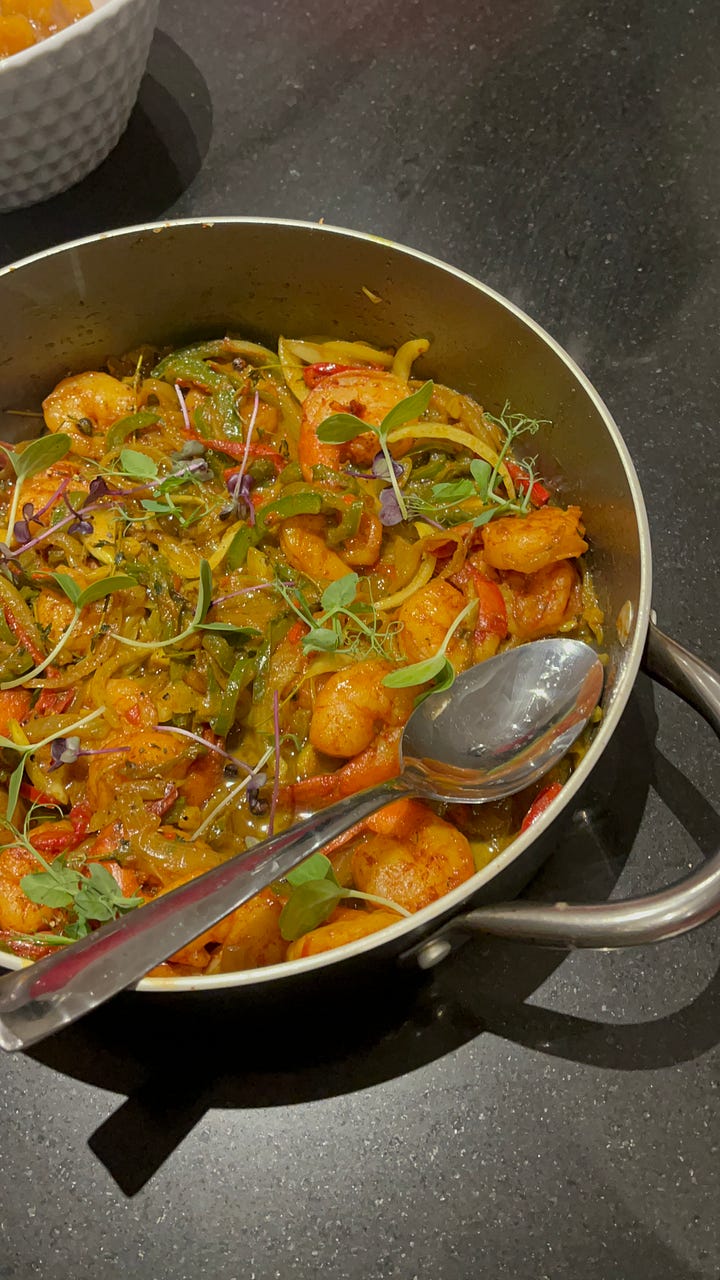
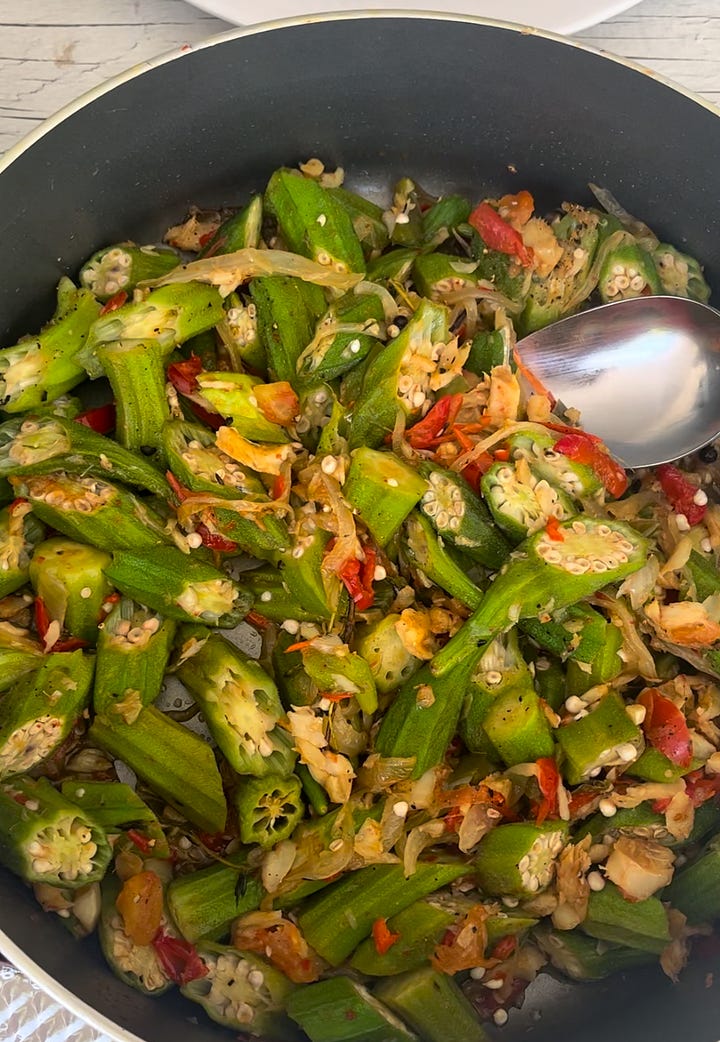
Collectively nodding our heads with satisfaction, we all wished we could eat like this every day. Our digestive systems have never been better. Our energy never higher. Conservations at the table became stories of women in our lives who nurtured us with the foods we forgot we loved. I realized then, that my idea of breakfast—the one shaped by American food culture, had erased a key part of my Jamaican heritage. Only up until semi recently, I’ve going back to eating salt fish and ackee with callaloo, and soup. Fish tea soup, corn soup, mannish soup, pumpkin soup or just soup or just fish. Ive been making soups. Co-signed my my darling nutritionist at Culina Health (highly recommend for my IBS baddies), prioritizing savory breakfast has been a way to get in my protein and veggie macros early on in the day has given me an abundance of energy. But more importantly, recreating savory meals from memory because of sweetness tasted in memories.

Living in a desolate area of Upstate New York, it takes a bit more an effort to locate ingredients, adopting a new diet but I find joy in finding the taste of my grandmother’s home in other places. I drive 51 minutes into the Albany “metropolitan” area, making way through my Bermuda triangle of grocery stories at South, East Asian, and Jamaican supermarkets followed by Trader Joes for snacks I don’t need and frozen meals for low energy and depressed days.
Even if I can’t find the exact ingredients I make substitutions for a Jamaican classic breakfast; sardines, when I can’t find salted cod, I’ll use kale, collards, or spinach in place of callaloo. I’ll use butternut squash to replicate the texture and sweetness of pumpkin and yellow yam. All delivering amicable flavor and textures. (I’ll do better to take photos next time).
Returning to my Jamaican heritage for breakfast has me feeling more energized, nourished, and connected. Switching up my routines has also led me to be curious about other breakfast traditions I have overlooked. Remembering some of my favorite meals from my travels last year in Akumal, Mexico, with Zoya Wellness, I remember that breakfast is not fixed, but an evolving ritual that could be shaped by seasonality, location, and preference.
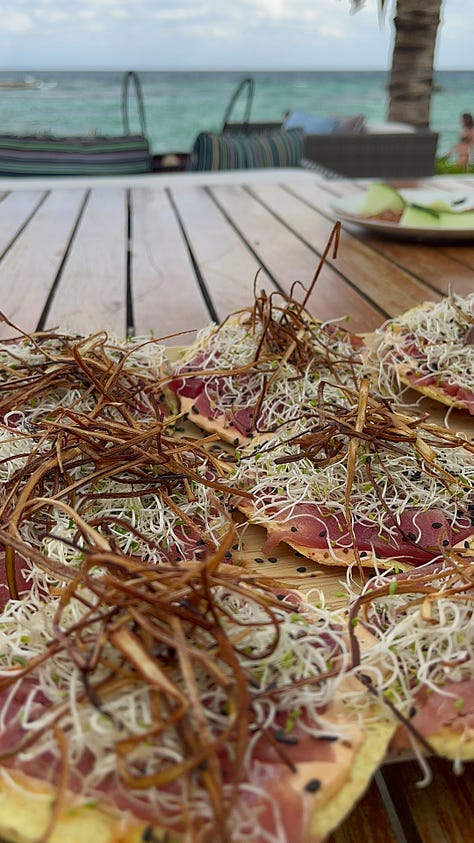
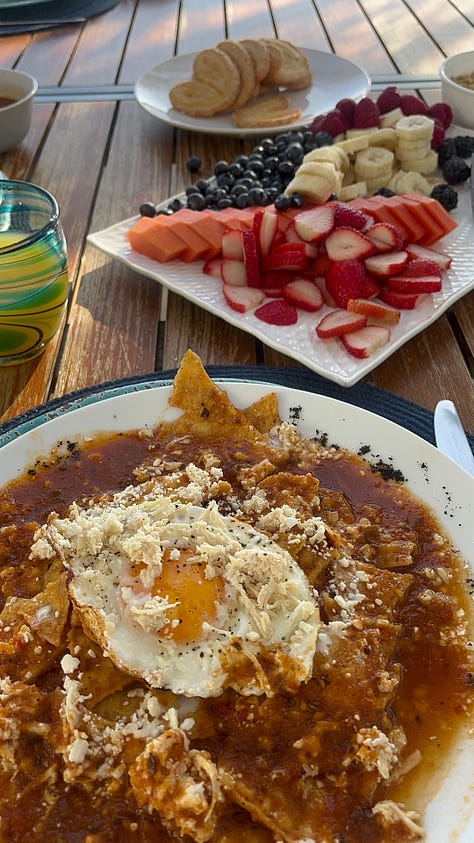
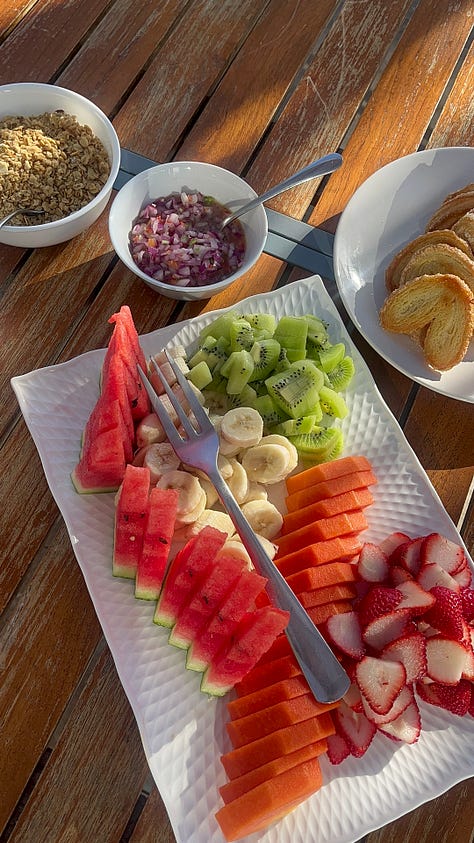
Aside from reclaiming Jamaican breakfast traditions at home I’ll making a conscious effort to search for Non-American Cafes during my visits in NYC. Navigating ever changing landscapes of food in NYC, I’m avoiding list on Eater or adjacent and I’ll be walking more slowly, more intentionally throughout NYC, stopping to explore storefronts owned by people from the diaspora that catch my eye. (I found an South Asian vegetarian restaurant with all brown uncles drinking chai on a Wednesday afternoon in Gramercy Park). I’ll be tapping into Reddit, my native New York friends, and their elders, to find local treasures that are pinnacle to communities of New York, and selectively gatekeeping.
In between my search for new brunch traditions, here’s are a few worldly breakfast that seem quick & ADHD friendly and quick that’s been on my radar to try.
** Disclaimer, I know I have beef with online recipes, but for research and development purposes I am intentionally seeking out food blogs ran by people who are actually of the diaspora **
Yemen - Fassoulia - White beans, onions, tomatoes, garlic, chili peppers, and spices cooked in tomato paste sauce, topped with eggs. (FRY MINE CRISPY AND HARD).
Americans clown the British for eating beans for breakfast, but I’m researching breakfast around the world, people are reaching their fiber goals before noon.
Tunisia - Shakshuka - Spicy tomato sauce made with onions, bell peppers, garlic, and spices like cumin and paprika, topped with eggs typically served with bread to soak up the sauce.
Lebanon - Ejjeh - herbed omelette with all the herbs. This whole website looks kinda fire.

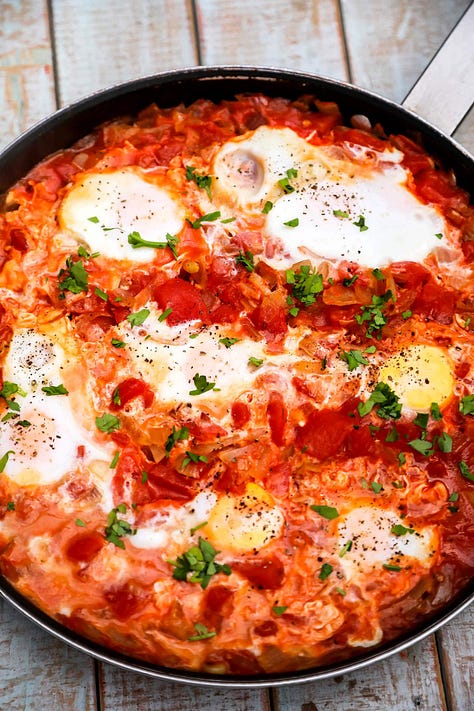

Despite the challenges of sourcing ingredients in Upstate New York, the process of adapting my breakfast has become a lesson in both creativity and patience. It’s no longer just about recreating the exact flavors of my grandmother’s kitchen, but about honoring the spirit of those meals with what’s available. Each substitution, whether it’s sardines for salt fish or butternut squash for pumpkin, is a small act of improvisation that keeps me connected to my roots while making peace with where I am right now, for now. I’ve come to realize that breakfast, much like identity, is not a fixed concept but an evolving one—shaped by memory, place, and the small victories of making something nourishing out of what’s on hand.
I am curious to know what is traditionally eaten wherever your family is from. Let me know. Let me know.
If subscribing is not an option, and you enjoy my work and want to support more stories, research, and kitchen experiments, consider buying me a coffee (or a bowl of fish tea soup). Your support helps me keep writing, cooking, and sharing with this community. 💛☕




I love this. I’m mixed, and pretty much grew up eating random mixes of the standard American diet with Spanish and black influences. But always struggled with breakfast. In the past few years I’ve googled and surfed for other breakfast options and hated how 80% of YouTube tutorials were eggs, overnight oats, and avocado toast. I kept (and keep) thinking on how these cannot be the same dishes people have really eaten for years. I even searched for “morning soup”, and struggled to find many recipes. I did find most cultures had a version of porridge, like Koreans have Dakjuk. I tried to make it (recipe from TikTok) but still need to get the flavors right. But you’ve inspired me to keep searching and continue to leave the SAD diet. There’s better, more flavorful and healthier experiences to have for breakfast out there.
I ditched the country breakfast of grits, eggs, some sort of pork, and biscuits I grew up on decades ago. Now, breakfast looks more like miso soup and pickled vegetables or some sort of little salad.